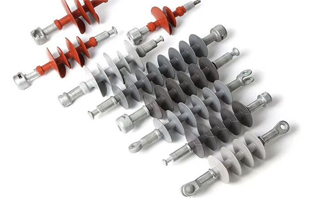There are several types of insulators, including pin, suspension, strain, shackle, post, stay, and disc insulators. When choosing an insulator, you can consider things like the voltage level, mechanical strength, and cost.
A lot of disk-shaped insulators are hung on one end of the high-voltage wire connection tower, which is to increase the creepage distance, usually made of glass or ceramics, called insulators. In order to prevent dust and other pollution from adhering to the surface of the insulator, the formation of a path is broken down by the voltage across the insulator, that is, creepage. Therefore, increase the surface distance, that is, the creepage distance. The distance of discharge along the insulating surface, that is, the leakage distance is called the creepage distance. Surface distance/system high voltage, depending on the degree of pollution, the creeping distance is generally 31 mm/kV in heavily polluted areas.
A zero-value insulator refers to an insulator whose potential distribution at both ends of the insulator is close to zero or equal to zero during operation.
The influence of zero-value or low-value insulators: The insulation of line wires depends on the insulator string. Due to manufacturing defects or external effects, the insulation performance of the insulator will continue to deteriorate. When the insulation, the edge resistance decreases or is zero, it is called low-value or Zero value insulators. We have inspected lines. The proportion of zero or low value insulators is as high as about 9%. This is another main reason for the high lightning trip rate of our company’s lines. The insulators are smooth, which can reduce the number of wires. In order to reduce the loss of current.

Composite Insulators
It is widely used in insulation and mechanical fixing of high-voltage overhead transmission lines and soft busbars of power stations and substations. In the suspension insulator, it can be divided into disc suspension insulator and rod suspension insulator. Disc suspension insulators are widely used in transmission lines. Rod suspension insulators have been widely adopted in Germany and other countries.
Mainly used for insulation and mechanical fixing of busbars and electrical equipment in power plants and substations. In addition, post insulators are often used as part of electrical equipment such as disconnect switches and circuit breakers.
In post insulators, it can be divided into pin post insulators and rod post insulators. Pin post insulators are mostly used in low-voltage power distribution lines and communication lines, while rod post insulators are mostly used in high-voltage substations.
The insulator is an insulator made of electrical ceramics. Electrical ceramics are baked from quartz, feldspar and clay as raw materials. The surface of the porcelain part of the porcelain insulator is usually covered with enamel to improve its mechanical strength, waterproof infiltration, and increase surface smoothness. Among all kinds of insulators, porcelain insulators are widely used.
The insulator is an insulator made of tempered glass. The surface is in a state of compression and prestress. If cracks and electrical breakdown occur, the glass insulator will break into small pieces by itself, commonly known as "self-explosion". This feature makes it unnecessary for glass insulators to perform "zero value" detection during operation.
Also called a composite insulator. The insulator consists of a glass fiber resin core rod, an organic material sheath, and an umbrella skirt. Its characteristics are small size, lightweight, high tensile strength, and excellent anti-fouling flashover performance. But the anti-aging ability is not as good as porcelain and glass insulators.
Composite insulators include rod suspension insulators, insulating cross arms, post insulators, and hollow insulators. Composite bushings can replace porcelain bushings used in a variety of power equipment, such as transformers, lightning arresters, circuit breakers, capacitive bushings, and cable terminals. Compared with the porcelain sleeve, it not only has the advantages of high mechanical strength, lightweight, and small dimensional tolerance but also avoids damage caused by the explosion.
Low-voltage insulators refer to insulators used for low-voltage power distribution lines and communication lines. High-voltage insulators refer to insulators used for high-voltage and ultra-high-voltage overhead transmission lines and substations. In order to meet the needs of different voltage levels, different numbers of single insulators of the same type are usually used to form insulator strings or multi-section insulation pillars.
The main measure is to increase or enlarge the umbrella skirt or umbrella edge of the insulator to increase the creepage distance of the insulator, so as to improve the electrical strength of the insulator in a dirty state. At the same time, the structure of the umbrella skirt is changed to reduce the amount of natural pollution on the surface to improve the anti-pollution flashover performance of the insulator.
The creepage ratio of pollution-resistant insulators is generally 20% to 30% higher than that of ordinary insulators, or even more. Pollution-resistant insulators with a double-layer umbrella structure are used in areas with frequent pollution flashovers in China's power grid. Such insulators have strong self-cleaning ability and are easy to clean manually.
We are an insulator supplier. If you are interested in our products, please contact us now!
+86 319 878 9350
+86 156 1304 7999
+86 319 878 9350
NanYan, DongHuan Road, Shahe, Hebei China
Copyright © Hebei Yipeng Line Equipment Co., Ltd. All Rights Reserved. | Sitemap Powered By 
